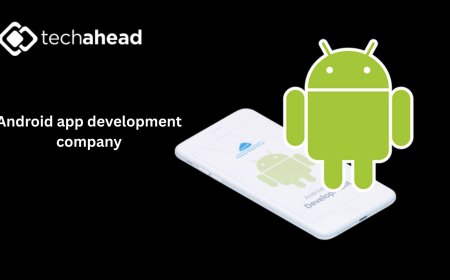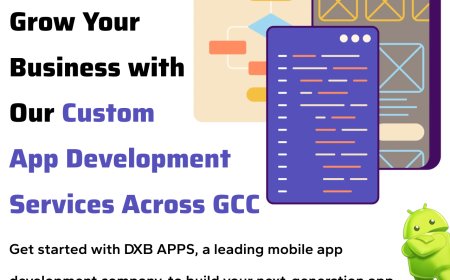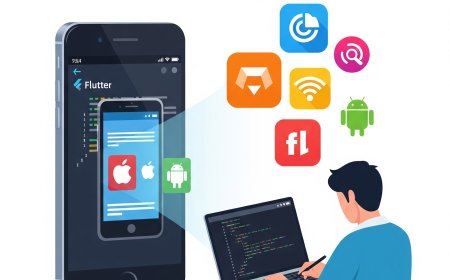AI-Powered Apps: How AI Development Services Are Reshaping User Experience

Introduction
What Are AI-Powered Apps?
AI-powered apps are mobile or web applications that use artificial intelligence to deliver smarter, faster, and more personalized user experiences. These apps go beyond simple programmed responsesthey learn from user interactions, adapt behavior over time, and often mimic human intelligence in functionality. Whether its a chatbot offering customer support or a personalized news feed on your social media app, AI is increasingly becoming the invisible engine behind seamless digital experiences.
At their core, AI apps rely on components like machine learning (ML), natural language processing (NLP), computer vision, and predictive analytics to function. For example, Spotify uses AI to suggest music, while apps like Google Photos organize images using facial recognition. In e-commerce, AI predicts what you want to buy before you even finish typing in the search bar.
These technologies are now being integrated into everyday tools, providing an intuitive and almost human-like touch to how we interact with apps. AI apps are not just about techtheyre about understanding people, and thats why businesses are pouring resources into AI app development services.
Why AI is Becoming the Core of Modern Applications
We live in a world of instant gratification, where users expect apps to not only function flawlessly but also understand them. AI makes this possible by allowing apps to learn from previous behavior and adjust accordingly. From autocomplete suggestions in messaging apps to smart scheduling in productivity tools, AI anticipates needs and removes friction.
But its more than convenience. AI helps businesses build relationships with their users. When your fitness app checks your progress and gives tailored advice, or when your banking app alerts you about unusual activity, it creates trust. And trust drives retention.
For developers, integrating AI is no longer a luxuryits a necessity. As the app market grows more competitive, standing out means offering experiences that feel intuitive, responsive, and even predictive. Thats why ai development companies are focusing on building intelligent apps that do more than just workthey wow.
The Evolution of User Experience (UX) in the Digital Age
From Static Interfaces to Intelligent Experiences
Not long ago, app interfaces were rigid and predictable. A button did one thing, a form collected data, and a screen simply displayed information. Fast forward to today, and users expect apps to feel dynamic, responsive, and personalizedmore like digital companions than tools.
AI is at the center of this transformation. It allows for adaptive designs that change based on user behavior, real-time responses that evolve with context, and intelligent suggestions that feel personal. Think about Netflixits homepage doesnt look the same for everyone. Based on your viewing habits, it rearranges the interface, highlights different categories, and even changes thumbnails. Thats AI redefining UX.
User experience has evolved from simple usability to emotional engagement. Apps now consider how users feel, not just what they do. And by analyzing behavior patterns, sentiment, and preferences, AI helps create interfaces that respond with empathy and relevance.
The Role of AI in UX Transformation
AI is the UX game-changer. Traditional design relied on static wireframes and assumptions about user behavior. Today, AI allows real-time feedback, adaptive elements, and continuous learning to drive smarter interfaces.
Heres how AI changes the UX landscape:
- Predictive Input: Auto-fill and smart suggestions speed up user actions.
- Context-Aware Design: Apps understand the time, location, and user status to deliver timely content.
- Conversational Interfaces: AI chatbots enable intuitive, human-like interactions.
- Visual Recognition: Image-based search and AR enhancements personalize the visual experience.
UX is no longer reactiveits proactive. And this shift is redefining what users expect from their apps. They want systems that get them, and AI is making that possible. Thats why AI app development services dont just code appsthey craft intelligent experiences.
Core AI Technologies Driving Modern App Development
Machine Learning and Predictive Analytics
Machine Learning (ML) is the backbone of intelligent apps. It allows apps to analyze data, learn from it, and make decisions without being explicitly programmed for every scenario. This is what powers everything from fraud detection in banking apps to fitness apps that adapt workouts based on performance.
With predictive analytics, apps dont just reactthey anticipate. For instance:
- A weather app might notify you about possible rain based on not just forecasts but also your daily schedule.
- A travel app may suggest the best time to book a flight using pricing trends.
ML makes these possibilities a reality. Its the technology that makes apps feel smart and helpful, rather than just functional.
Natural Language Processing (NLP)
NLP enables apps to understand, interpret, and respond to human language. Think Siri, Alexa, or the AI in your customer support chat. These systems parse natural language, understand intent, and deliver responses that feel conversational.
NLP is used in:
- Voice assistants
- Chatbots
- Language translation
- Sentiment analysis
This adds a human touch to apps, turning commands into conversations and making interactions smoother and more engaging. Its also a critical component for accessibility, enabling voice-powered navigation for visually impaired users.
Computer Vision and Image Recognition
Computer vision allows apps to see and interpret images, opening the door to a host of visual UX enhancements. From scanning receipts to facial recognition for secure logins, image-based AI makes apps more interactive and secure.
Examples include:
- Retail apps letting users try on clothes virtually
- Healthcare apps analyzing medical images
- Social media platforms tagging people automatically
These features reduce effort, improve engagement, and often feel like magic to userswhich is exactly what modern UX is all about.
Recommendation Engines and Personalization
Every user wants to feel special. Recommendation engines use AI to make every app experience personal. Whether its Spotify crafting your Discover Weekly or Amazon suggesting the next best product, AI drives relevance.
These systems track:
- User preferences
- Historical data
- Real-time behavior
Then, they serve up content, products, or services that feel tailor-made. This level of personalization doesnt just enhance UXit builds loyalty.
Key Features of AI-Powered Apps Enhancing User Experience
Hyper-Personalization
In todays crowded app marketplace, personalization is not just appreciatedits expected. AI-powered apps take this concept to the next level with hyper-personalization, which uses real-time data, user behavior, preferences, and even emotional cues to deliver a uniquely tailored experience for each individual user.
For instance, a fitness app might not only track your steps but also learn your workout preferences, dietary habits, and daily routines. It could then suggest workouts that fit into your schedule, push reminders when you tend to skip workouts, and recommend meal plans based on your past selections. All of this happens dynamically, driven by machine learning models trained to understand your specific behavior.
Hyper-personalization also plays a critical role in:
- Retail apps showing you product deals youre likely to buy
- Finance apps offering savings tips based on your spending habits
- News apps tailoring content feeds to your reading patterns
By making every touchpoint relevant and personalized, AI-powered apps build deeper engagement and drive higher user retention. Users feel like the app knows them, and that emotional connection makes all the difference.
Real-Time User Interaction and Feedback
AI apps excel at delivering instant feedback and interaction, turning static user experiences into dynamic conversations. Think of a grammar checking app that suggests corrections as you type, or a photo app that enhances your image the moment you upload itthese are all examples of real-time AI in action.
Such interactions increase user satisfaction because they:
- Speed up task completion
- Reduce user frustration
- Improve learning and confidence
For example, a language learning app using AI can recognize pronunciation mistakes and correct them immediately, creating a faster and more effective learning experience. Similarly, real-time translation in travel apps makes navigating foreign countries smoother and less intimidating.
These feedback loops are also self-improving. As users interact with the app, the AI collects more data, refines its algorithms, and gets better at providing timely, relevant responses. The result? A smarter app and a more intuitive experience with every use.
Intelligent Automation and Convenience
Nobody likes repetitive tasks. AI-powered apps relieve users from mundane actions by automating them intelligently. Whether its automatically tagging photos, categorizing emails, or filling out forms, intelligent automation makes the experience smoother and more efficient.
Some standout examples include:
- Calendar apps that schedule meetings based on availability
- Travel apps that generate itineraries based on your bookings
- Banking apps that auto-categorize expenses for budgeting
But its not just about saving timeits about reducing cognitive load. By minimizing the number of steps required to complete a task, AI-driven automation makes apps feel effortless. And when things feel easy, users are far more likely to return.
Real-World Applications Across Industries
AI in E-commerce and Retail Apps
Retail and e-commerce have been early adopters of AI, and for good reason. AI enhances nearly every step of the buyers journeyfrom product discovery to purchase and post-sale support.
Examples of AI in retail apps include:
- Visual search engines that let users snap a photo of a product and find it online
- Dynamic pricing algorithms that adjust costs based on user behavior and demand
- Recommendation systems that increase average order value
One standout example is the frequently bought together feature on Amazon. Its powered by AI analyzing millions of shopping behaviors to surface the most relevant suggestions. The result? Personalized experiences that increase revenue and satisfaction simultaneously.
Retailers also use AI to reduce returns and enhance loyalty by offering size predictions, smart customer support bots, and personalized deal notificationsall designed to improve the user journey and boost conversions.
Healthcare and Wellness Apps with AI Capabilities
The healthcare industry has seen a surge in AI-powered apps aimed at making care more accessible, personalized, and proactive. From fitness trackers that monitor your vitals to AI chatbots that offer mental health support, AI is democratizing wellness.
Key use cases include:
- Symptom checkers powered by NLP and medical databases
- AI fitness coaches offering real-time form corrections during workouts
- Telemedicine platforms that match patients with the right specialists
AI not only improves the user experience but also saves lives by enabling early diagnosis, remote monitoring, and personalized treatment recommendations. As health-conscious consumers look for smarter tools, AI-powered wellness apps are becoming essential.
AI in Banking and Fintech Mobile Solutions
In banking, AI is driving a revolution in how users interact with their finances. It goes beyond mobile check deposits or budgeting tipsAI is enabling intelligent financial advice, fraud detection, and spending insights at the users fingertips.
Notable features include:
- Smart assistants that suggest how to save or invest
- Real-time fraud alerts that analyze suspicious behavior
- Transaction categorization for clearer budget tracking
For example, apps like Cleo use conversational AI to explain spending habits in fun, engaging ways. Others offer personalized investment portfolios, based on user preferences and goals. This level of interaction makes finance less intimidating and more empowering.
AI in EdTech and Personalized Learning Platforms
Education apps are leveraging AI to offer personalized learning paths, intelligent tutoring, and adaptive assessments. These platforms analyze student performance and adjust the content difficulty accordingly, ensuring learners stay challenged but not overwhelmed.
Use cases include:
- Language apps that focus on weak vocabulary areas
- STEM platforms that recommend topics based on quiz performance
- Essay grading AI that gives real-time writing feedback
Apps like Duolingo and Khan Academy are trailblazers in this space, making learning fun, fast, and tailored to each students pace. As remote and hybrid education grows, so does the need for smarter, AI-powered experiences.
Benefits of AI App Development Services for UX
Faster Response Times and Improved Accessibility
AI dramatically reduces the time users wait for responses or results in an app. Instant search suggestions, quick replies via chatbots, and real-time updates make apps feel fast and fluid, which is critical for maintaining user interest. In the modern digital landscape, speed equals satisfaction.
Imagine a user shopping on an e-commerce platform. Instead of typing in a full query, they start entering a product name, and the app immediately offers suggestions, completes the phrase, or shows matching items. This level of responsiveness wouldnt be possible without AI predicting user intent and optimizing content delivery behind the scenes.
AI also plays a crucial role in accessibility. It powers voice recognition for hands-free app interaction, real-time captioning for video content, and text-to-speech features for visually impaired users. Tools like Googles Lookout or Apples VoiceOver are prime examples of how AI enhances usability for all.
By making apps more responsive and inclusive, AI doesnt just improve user experienceit expands the user base by making digital products usable by more people, regardless of ability.
Adaptive User Interfaces Based on Behavior
AI-driven apps dont look the same to every user, and thats a good thing. Adaptive UI (User Interface) design powered by AI tailors the layout, navigation, and functionality of an app based on individual usage patterns. This results in an interface that learns from the user and becomes more efficient over time.
For example:
- A news app might place sports stories front and center for a user who always reads sports headlines.
- A banking app may rearrange menu options based on frequently accessed features, like transfers or bill payments.
- A fitness tracker could highlight health metrics that are most relevant to a users specific goals.
This dynamic customization not only improves user satisfaction but also increases productivity and app engagement. Instead of forcing users to adapt to the app, the app adapts to themcreating a more intuitive and enjoyable experience.
Smarter User Journeys and Flow Optimization
A smooth user journey is vital for retaining users, and AI is becoming a master of optimization. By studying user behavior, drop-off points, time spent on each screen, and interaction frequency, AI can recommend changes to the app flow in real time.
For instance, if data shows that users are abandoning a checkout process midway, the app can tweak the flowmaybe by simplifying the form, removing unnecessary steps, or offering real-time assistance via chatbot.
AI can also:
- Highlight call-to-action buttons at optimal times
- Offer progress indicators to guide users through tasks
- Provide just-in-time tips or tooltips to reduce confusion
The result? Fewer abandoned processes, better conversion rates, and happier users. Developers working with AI app development services gain a strategic advantage by constantly refining the UX based on real-time feedback and analytics.
How AI Enhances Engagement and Retention
Gamification and Behavioral Analytics
Keeping users engaged over time is one of the toughest challenges in app development, and this is where AI shines. By leveraging behavioral analytics, AI identifies what motivates each user and applies gamification techniquesrewards, achievements, levels, streaksto keep them coming back.
A productivity app might reward users with badges for completing daily goals. A language learning platform could track learning streaks and offer encouragement when progress dips. These are not random rewardsthey are strategically timed and tailored using AI.
Behavioral AI analyzes:
- Usage frequency
- Task completion rates
- Time spent in specific features
- Drop-off moments
Based on this data, the app can send personalized nudges, content, or reminders that are most likely to reignite user interest. This intelligent engagement strategy reduces churn and increases lifetime value without relying on annoying or generic push notifications.
Proactive Support and Smart Chatbots
AI-powered chatbots have evolved from simple FAQ bots to sophisticated virtual assistants that offer real-time, context-aware support. When users encounter a problem, these bots can provide instant answers, walk them through a process, or escalate the issue to a human agent when needed.
What makes them so effective?
- They are available 24/7
- They handle multiple users simultaneously
- They learn and improve with every interaction
Proactive AI support also means predicting issues before they occur. For example, if a user repeatedly struggles with a feature, the app might offer a guided tour or suggest an easier alternative. This level of attentiveness makes users feel supported and understood.
And the best part? All this happens without increasing customer support costs, making AI an investment in both UX and operational efficiency.
Best Practices in AI App Design and UX Strategy
Aligning AI Capabilities with User Goals
One of the golden rules in AI app development is: dont use AI for the sake of it. Instead, AI should directly serve the users goals. Whether that goal is finding a product faster, completing a task more efficiently, or getting personalized content, AI should enhance the experience, not distract from it.
This means starting with user personas and user journeys, identifying friction points, and then applying AI where it creates the most impact. Maybe its simplifying navigation, anticipating questions, or reducing manual data entry.
AI works best when it is:
- Seamlessly integrated into the UX
- Transparent and trustworthy
- Focused on user value, not just novelty
By aligning AI capabilities with actual user needs, businesses can deliver apps that not only wow users but solve real problems effectively.
Ethical AI Use in UX
As AI becomes more integrated into our digital lives, so does the importance of using it ethically. Users should always know when theyre interacting with AI, how their data is being used, and what decisions the AI is making on their behalf.
Best practices include:
- Clear disclosures when AI is involved
- Consent-driven data collection
- Bias testing to ensure fairness in algorithms
- Explainability features that let users understand how decisions are made
Ethical AI builds trust and credibility, which are key to long-term success in app development. Users are more likely to engage with apps that respect their privacy and treat them as individualsnot just data points.
Continuous Learning and UX Feedback Loops
AI apps arent a one-and-done project. They need to learn and evolve constantly. This means setting up feedback loops where user data, feedback, and behavior are continuously analyzed to improve the app.
Examples include:
- A/B testing with AI to identify the most effective UI elements
- Automated user surveys after feature use
- Behavior-based updates to interface design or content
The development process becomes iterative and data-driven, ensuring that the user experience keeps getting better over time. AI app development services that adopt this mindset can deliver apps that stay relevant, competitive, and loved by users.
Challenges in Building AI-Enhanced User Experiences
Data Privacy and Trust Concerns
As powerful as AI can be, one of the biggest barriers to user adoption is trustspecifically around how their data is being collected, stored, and used. AI relies heavily on user data to function effectively, which raises concerns about data privacy, surveillance, and misuse.
Users are becoming increasingly cautious. They want to know:
- What kind of data the app collects
- Why its being collected
- Who has access to it
- How long it will be stored
Failing to address these questions clearly can result in loss of trust, negative reviews, and even regulatory penalties. GDPR, CCPA, and similar laws now hold businesses accountable for how they manage user data.
To mitigate these concerns, AI app development services must implement:
- End-to-end encryption
- Data anonymization
- User-controlled privacy settings
- Transparent privacy policies written in plain language
Moreover, developers must train AI models responsibly, avoiding biased or incomplete data sets that could lead to discriminatory outcomes. Ethical and privacy-centric development isnt just about complianceits about earning and maintaining user loyalty.
Balancing Automation with Human Touch
While automation makes apps more efficient, over-automating can lead to frustration, confusion, or a sense of detachment. Theres a fine line between being helpful and being intrusive.
For example, a chatbot that doesnt understand a users request or wont transfer them to a human agent when needed can quickly damage the user experience. Similarly, an app that automatically changes settings or content without user consent can leave people feeling out of control.
The key is to blend automation with empathy:
- Always offer a manual or opt-out option
- Let users easily reach human support when needed
- Provide transparency on how automated decisions are made
By designing AI interactions that feel human-centricnot roboticdevelopers create apps that are both smart and emotionally intelligent. Users dont just want convenience; they want to feel heard and respected.
The Future of UX: Predictions for AI in App Development
Emotion AI and Empathetic Interfaces
The next frontier of AI in UX is emotion recognitionAI systems that understand and respond to human emotions. This might sound like science fiction, but its already in motion. Emotion AI (also known as affective computing) uses voice tone, facial expressions, typing speed, and other indicators to detect how a user feels.
Imagine:
- A learning app that offers encouragement when it senses frustration
- A mental health app that adjusts tone based on detected stress
- A customer service chatbot that escalates the chat when sensing anger or dissatisfaction
These capabilities could transform user experience into something deeply empathetic and responsive. However, it also comes with ethical challengesespecially around consent and emotional manipulation. Thats why future development will focus not just on whats possible, but also on whats responsible.
Voice-First Interfaces and Multimodal UX
As smart speakers and voice assistants grow in popularity, voice-first design is becoming a major UX trend. Apps that understand and respond to spoken commands create hands-free, seamless interactionsespecially important in scenarios like driving, cooking, or multitasking.
But it doesnt stop at voice. The future is multimodal UX, where apps respond to a combination of inputs:
- Voice
- Touch
- Gesture
- Facial expressions
- Eye movement
This opens the door for more immersive, intuitive experiences that adjust to context and preference. Whether its switching from typing to speaking or using your gaze to scroll through a menu, AI will enable fluid transitions between input modes, making apps more accessible and user-friendly than ever before.
Choosing the Right AI App Development Service
What to Look for in a UX-Focused AI Partner
With so many AI development companies on the market, how do you find the right one? The best partners dont just build appsthey craft experiences. Look for a firm that:
- Specializes in UX strategy and AI integration
- Offers case studies with measurable results
- Prioritizes ethical and privacy-first development
- Has strong cross-functional teams (data scientists, UX designers, engineers)
- Provides ongoing support and AI model training after launch
Ask about their design-thinking process, their approach to testing and feedback, and how they measure UX success. A true partner will be as committed to your users as you are.
Case Study: A Successful AI-Driven App Experience
Lets take the example of a mobile fitness platform that partnered with an AI development company to improve engagement. The app used machine learning to analyze each users fitness level, goals, and preferences. Based on that, it provided daily workout recommendations, smart calorie tracking, and even motivational feedback using natural language processing.
Within six months:
- User retention increased by 43%
- Daily active users grew by 60%
- The app earned a 4.9-star average rating on app stores
By focusing on AI-powered personalization and empathy, the development team turned a generic workout tracker into a digital fitness coach that users genuinely connected with. Thats the power of strategic AI and UX working in harmony.
Conclusion
The integration of artificial intelligence app development is reshaping what users expect from digital experiences. From personalization and automation to emotional intelligence and real-time feedback, AI is creating apps that feel smarter, faster, and more human than ever before.
But successful AI-powered apps arent built on code alonetheyre crafted through deep understanding of users, thoughtful design, and strategic implementation. Thats why more businesses are turning to specialized AI app development services that bring together data science, design thinking, and a relentless focus on user experience.
Whether youre launching a new app or upgrading an existing one, AI isnt just a featureits the future of UX. Embrace it wisely, design it ethically, and youll not only meet expectationsyoull exceed them.
FAQs
Can AI improve app usability for non-tech-savvy users?
Yes, absolutely. AI simplifies complex processes, offers smart guidance, and can even respond to voice commandsmaking apps more intuitive and easier to navigate for all users, regardless of tech skill.
How does AI personalization differ from traditional customization?
Traditional customization relies on manual user input (e.g., changing settings), while AI personalization uses behavior, preferences, and context to automatically adjust the experience in real-time, often without user effort.
Is AI integration costly for small app developers?
While advanced AI solutions can be expensive, many cost-effective options now exist, including AI-as-a-Service platforms and open-source libraries. Working with an experienced development partner can help manage costs effectively.
What industries benefit most from AI-driven UX?
Industries such as e-commerce, healthcare, fintech, education, and entertainment see the biggest gains, but AI can enhance UX in virtually every industry by improving personalization, automation, and efficiency.
How do I ensure my AI app is ethically designed?
Start with transparent data policies, consent-driven features, and inclusive datasets. Work with a partner that values responsible AI practices and implements fairness, explainability, and bias mitigation into their models.





































